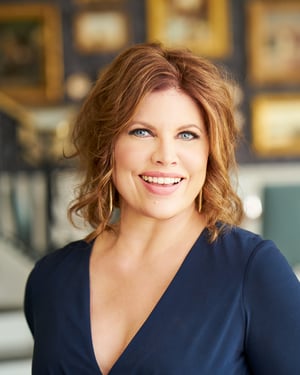The life of the modern interior designer is a complicated one, much more so than ever before. One thing, however, has never changed: Every designer must get clients to sign on the dotted line.
The September 2018 issue of Dallas Market Center’s Designers’ Guide asked A-list interior designers from across the country for the inside story—the secret tricks of the trade, if you will—on how they make it happen. Their answers are instinctive, intuitive and, most of all, informative.
Dallas Market Center Asks: Interior design prospects are a dime a dozen, but clients, not so much. What are your best marketing techniques, including your pitch, visual aids and even pricing, to help you turn all those potentials into actual paying clients?

Denise McGaha
Designer, Denise McGaha Interiors
Dallas, Texas
“I believe in identifying your perfect client before you ever receive a phone call. We believe the match is almost immediate when a prospect fits all of the criteria of the perfect client for your firm. Identifying those key traits is what helps you identify a client in-the-rough.
“We also work within a specific niche of design. Ours happens to be ‘Designing with a Deadline.’ Clients want to know what you do differently than other firms, and I believe your process to deliver a look is as important as the look itself. We find clients that identify with that.”
 Dann Foley
Dann Foley
Principal, Dann Foley Lifestyle
Palm Springs, California
“For us, an initial meeting is all about enthusiasm and exciting ideas from the start.We always talk budget, and we do so frankly. As a professional with many years of experience, I know what a job will cost and I share that number openly, honestly and completely.
“A varied portfolio is very important to us. I want potential clients to see the breadth and extent of our design capabilities. We never present someone else’s work to suggest a style for any of our projects. [We also do] hand sketches in the moment to excite our clients to move forward more quickly and spend more money!”
 Libby Langdon
Libby Langdon
Designer, Libby Interiors, Inc.
New York, New York
“These days, with a visit to Houzz or Pinterest, a consumer can zero in on the exact look they want. They don’t always need you for that, [so] I explain that I’m actually going to save them money. I have a sample living room furnishings proposal that shows all the items that I would buy for a space. Next to each item is the retail price, and then it shows the price I’d sell it to the client for, which is significantly less. The two columns are totaled, showing what it would cost if they bought it themselves, versus me buying it for them, and they are always blown away!
“I also believe in having people read reviews from your past clients. Even if you hate Houzz, it’s a fantastic platform for your clients to review what it was like to work with you. If you haven’t asked your clients to give you reviews, you should - will make you feel like a million bucks! When I send a potential client to my Houzz reviews page, we usually get a request for a contract within a day.”
Shay Geyer
Owner & Designer, IBB Design Fine Furnishings
Frisco, Texas
“Over the years, we’ve curated our own ‘little black book’ of resources that allow our designers to provide an invaluable experience to our clients. Having the best of the best at our fingertips gives us the advantage to create bespoke interiors tailored to our clients’ needs on time and in budget.”
 Kelli Ellis
Kelli Ellis
Designer, Kelli Ellis Interiors, Inc.
Rancho Santa Margarita, California
“I appeal to the psychology of my clients first. I created the Design Psychology Coaching Certification program to address this very question. Clients are very savvy, and need to understand the ‘why’s’ of design choices, not just that we know how to make things pretty. They want to feel heard and understood.
“A pretty portfolio is not enough anymore. We are bombarded with picture-perfect portfolio snaps on every social media platform. You need to understand what makes you different as a designer, and how you can best relate to your clients on a personal level.”
 Shayla Copas
Shayla Copas
Principal Designer, Shayla Copas Interiors
Little Rock, Arkansas
“I developed an in-depth client intake form a couple of years back that helps us to not only evaluate the project, but to better understand the client. Our intake process covers lifestyle, entertaining, how the space will be used, design aesthetic preferences and much more. We initiate an intake call after reviewing the form to discuss the project further and to get to know the client better. After we have had our intake call, we schedule a site visit.
“Clients want to know that a designer has put in the time to understand their needs, and they want a designer who will listen to them. We have found that this intake process helps us better understand the client and bond with them, as well.”
 Kristi Hopper
Kristi Hopper
Designer, Kristi Hopper Designs
Coppell, Texas
“I always say that the first thing I do is sell, because I have to sell myself and my knowledge to the client to get in the door. After that, I become a psychologist. I have to figure out who is the decision-maker in the household and what they want, versus what they need and will pay for. I always ask what the client does for a living and how many kids or pets they have to figure out their household dynamic.
“I qualify the client on the first call by asking a lot of questions, and I charge an initial consultation fee. If they accept the consultation fee, then they are probably interested in hiring me. I also normally tell them to check out all of my social media and my website, which gives them insight into what we do.
“Once I’m with a client, I make sure they know that I am an expert in my field by explaining all aspects of the job and how we will accomplish what they want. I normally throw out a number that I think will cover the costs of what they are asking me to do. If they immediately balk, I ask what budget they have in mind, and I try to let them know what they can expect to get for their budget. I always go over pricing before we start the process of selection, and I make sure they understand the costs associated with everything we do.”

